Blog
The Festival as Form is a project thinking about what festivals do to poetry. A page prints a poem, and gives it a layout. A magazine puts a poem alongside news or other poems, so they often seem oblique comments on each other. A platform gives a poet a space to talk and a room to hear her voice coming back - and usually also packages the reading inside a venue, a scene, a genre, a series, or a funded soft-power network. But what does a festival – that multi-stage, non-stop, all-round theatre of theatres – do? It’s a serious question, because most of the UK’s major music festivals have sprouted poetry and literature stages over the last 10 years, and the data from the booksellers is that most people who are not already poetry fans or locked into GCSE English encounter most poetry at festivals.
Of course the word ‘festival’ covers a huge range of types: urban festivals to stroll round vs. camping-based mudbaths; festivals gathering the tribe vs festivals trying to be beyond any tribe; expensive spa-treatment festivals vs. freebies on the beach; the Edinburgh Festival vs. the home-made one you put on in your grandad’s scout tent with a five-string guitar and a pot plant. But none of them are about reading poetry silently on the sofa. We’re sampling a range of poetry at festivals this year to try to hear what the festival is doing to them, and how it works as a format for the literary arts. We chose poetry as our way in, not only because we love it, but because it’s low-tech and high-sensitivity, which means it can shift and take new directions as things are happening in the room or outside the tent. The more complex the show, the less it can change direction once it’s launched. But festivals are mobile affairs with thin boundaries – literally so, in the canvas ones – and so poetry is our seismograph.
Bristol Harbour Festival
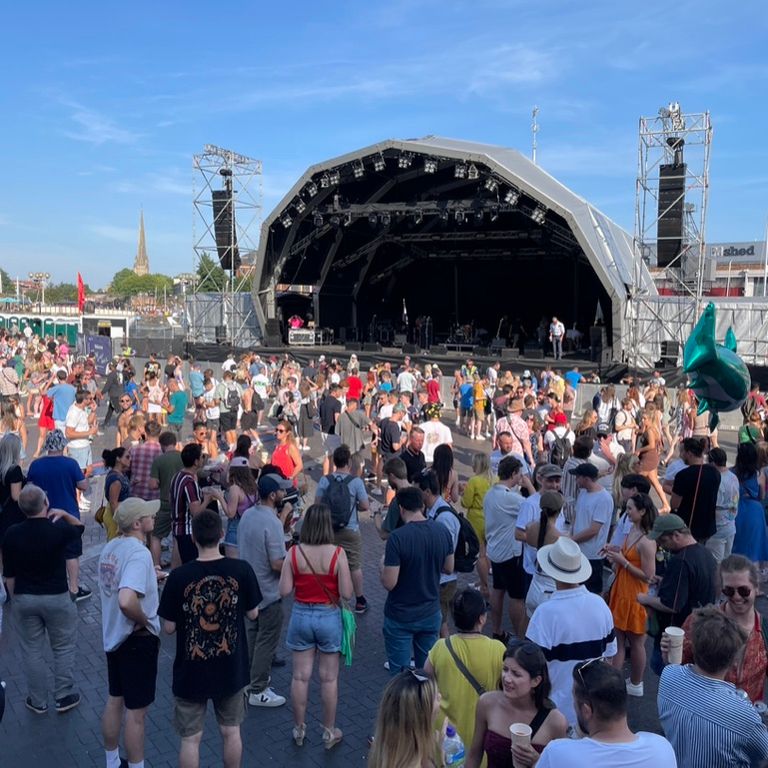
A few weeks ago we sat in the poetry tent at the Bristol Harbourside Festival, which is a free urban festival based around the much-regenerated Bristol Docks area. Free creative-city events are now fixtures in most ambitious civic calendars. They started in the late 90s as events that would celebrate the artists and small producers in a place, and, more optimistically, make your formerly industrial quarter sound like it was cool, drawing jobs and the ‘creative classes’ to rent workspace or purchase apartments on brownfield sites. The backdrop is the familiar one of manufacturing jobs going to China and their industrial remnants becoming aestheticized for small scale entrepreneurship: bare-bulb coffee shops, shed-like warehouses turned in art galleries, and many tattoos. Richard Florida’s influential textbook The Rise of the Creative Class said it could be indexed by the number of gay couples you could attract to the area. This was a daft piece of shorthand with real-world consequences, because he was providing planners with a cliché of the high-spending child-free couple as their model creatives, meaning flats for double-income mortgages and no need to build schools or daycare.
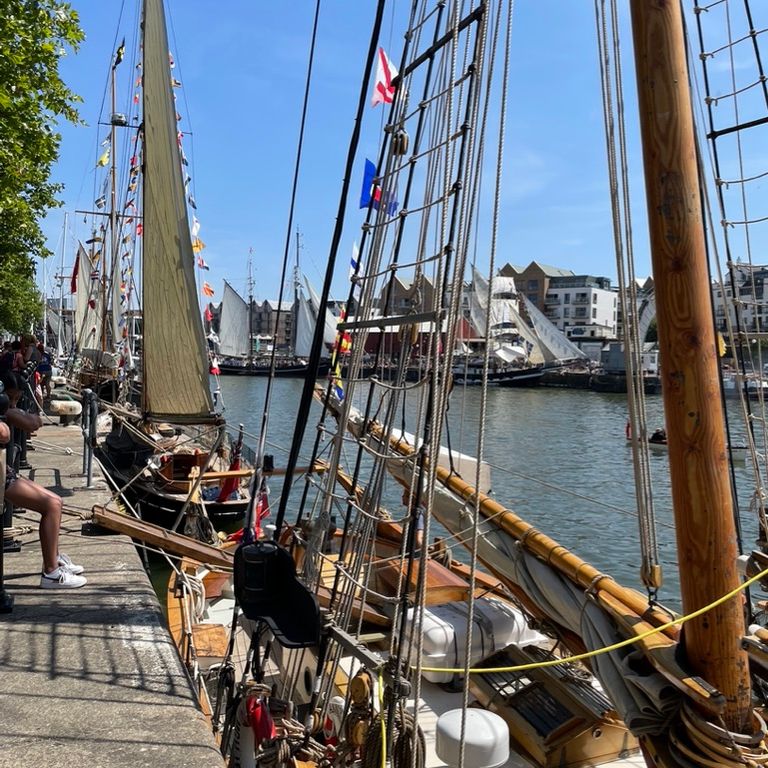
But as important to the festival was Florida’s conviction that we think the city itself as experience: not a background infrastructure, but a continuous zone of stimulation discovered through walking, architecture, novel food, photography, bars, the exposure of layers of history in the present, and the performative connoisseurship of it all, a process hugely boosted by the proliferation of smartphones and social media. Festivals fitted brilliantly into this idea, because they are also continual strolling experiences full of global food, pop-up stalls, and entertainment where everyone is a performer. If you are not on stage or interacting with it, you are sharing photos of yourself having a brilliant time to your Instagram feed. In 2014, Nikolay Zherdev called the results of ten years of successful consultancy by Florida and his team the ‘festivalization of the city’ – meaning not, as you might think, that your city would be temporarily taken over by its festival, but that cities were being re-modelled to be in year-round festival mode, pedestrianised, re-lit and re-zoned. In Bristol, the dockside has been reclaimed for walking round, with heritage boats, warehouse bars and permanent outdoor fairy lights, with waterfront living and low-rise office blocks a step back. It’s a pleasant stroll, but it means that when the festival comes, it doesn’t feel like any interruption of business or carnivalesque reversal, just an intensification of the circuit already there. Approaching from the side, I wondered how the mainstage music arena created so little sound boom, given the impressive noisiness of the Bristol guitar scene. Then I realised that one of the banks in the Harbourside had been built in a curve so that on weekends, it could be the back of an amphitheatre to contain the sound for just this kind of event.
Shady poetry in...
But Zherdev also noticed that the parts of festivals run by artists don’t always fit Florida’s version of ‘creative atmosphere’. The Poetry tent at Bristol was stationed in a shady walkway the other side of the bank, and it was hot, so passers-by stopped, and kept stopping. In front was the open-sided tent and a lawn to sit on:
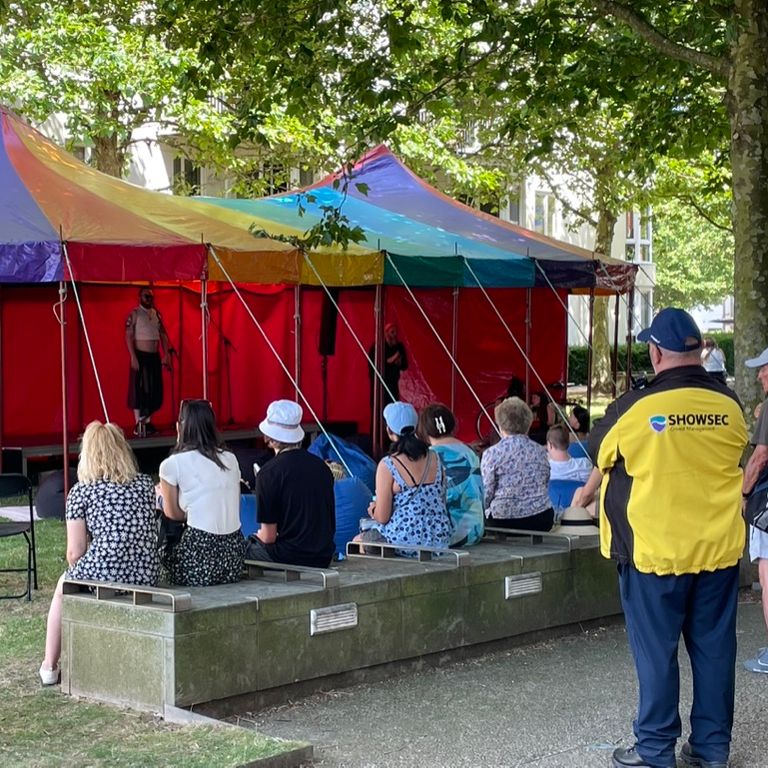
...temporary spaces
And immediately behind was someone’s festival accommodation for the night before.
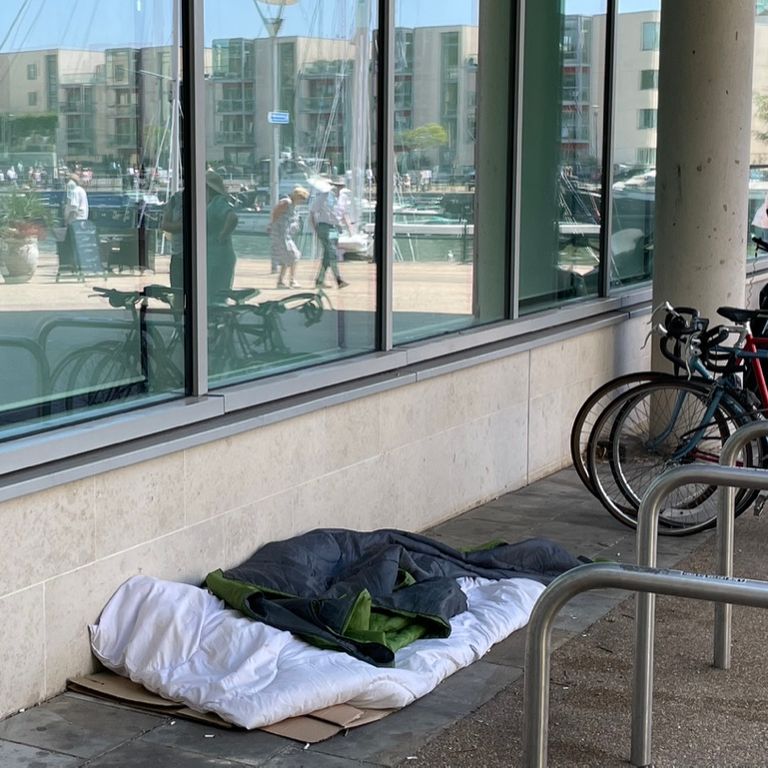
You couldn’t turn away from Bristol’s housing shortage by looking back at the poetry, either. Kat Lyons, Bristol’s new Poet Laureate, wondered how the city could win the ‘most liveable’ prize in some newspaper league table while actual rents run rings round local incomes. A Herefordshire poet calling himself 1990s Chris asked if there were any landlords out there – one brave hand went up – before describing his hopeless attempts trying to find a place to live. Rightmove, he said, is like Tinder, building the illusion of control with multiple filters, when really you’re not attractive enough and the only route to a match is have lots of money and no preferences at all. Winningly, he then apologized for not sticking around after the performance: ‘I’m on my lunch break. I’ve got to go back to work after this’. After her stint working in the Met Office, Liv Torc pointed out that half of Somerset is going to be homeless as the water levels rise.
Poetry as shelter
And had you wandered off through the festival to the SS Great Britain, you might have seen art from the Bristol Refugee Festival, or have discovered performance artist Rachael Clerke hosting the GRIT awards; handing out gongs to any overcrowded Bristolian who’d stood up to their estate agent or actually got their landlord to fix something.
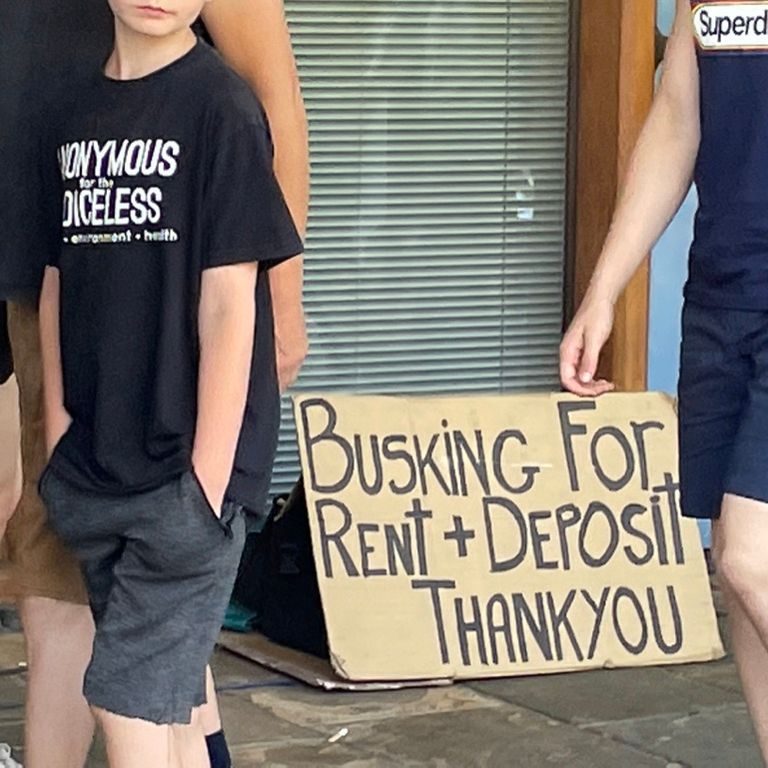
But I don’t want to make the poetry tent sound like it was issue-driven ranting. In fact, the poets’ observations about homes were made within a much wider spread of dramas of precarious living, starting with their own nerves about being there. There were memorable poems about being on the edge of life in hospital, living from blood test to blood test (Liv Torc); being a raver ‘glaring at the day to days’ but feeling alone in the windy dark (Eve Piper); being between genders (Jasmine Gardosi); being in a kebab shop in full sparkly costume (‘1990s Chris’); being horribly drunk and finding your mum’s in casualty (Millie Wood-Downie). ‘They tell it like it was your life’, the security guard you can see in the yellow jacket above suddenly remarked to me, as Wood-Downie finished. ‘I recognise that. I’ve been 11 years in AA. I’m just walking past and the hairs on the back of my neck are standing up’.
This wasn’t the wholly positive celebration of Bristol's various communities that the festival PR might have liked. The poets were calling up uncomfortable lives, and they were doing it in a space where everyone is feeling a bit on edge: pushed along by a crowd, taking temporary shelter where they can find it, unsure where they’ll be in a few minutes or what they will eat or whether there will be toilets. Festivals are experiences of temporary precariousness, even if people are not actually living in a tent. The official 2022 theme was ebb and flows, which makes the movement of people round the festival or the city’s history sound gentle and inevitable. But the poets were performing distress, threat and pressure in a way that stopped passers-by and kept them for twenty minutes or more. ‘We give you our misery but in a vulnerable and charismatic way’, another act, Tom Sastry, quipped. What Rebecca Tantony's poetry tent was also doing, I realised, was curating us, its audience; making a drift of strangers into a group who wanted to listen with care. The louder music stages or the dance could turn passers-by into watchers and clappers, but out of the glare and with the volume back down, only poetry could turn one corner of the festival space into a kind one.
I’m not sure how much this niche has made it into the festival literature. Florida’s idea that whole cities could prosper by following the edgy and disruptive lead of bohemian creatives seemed to give artists real respect. But really, The Rise of the Creative Class implied, there was nothing so controversial or shocking that an artist could do which couldn’t be recuperated by the city for reputational marketing. Cities, like festivals would always license dissent, in order to recuperate it. Kindness, though, is harder to notice, and to market.
WOMAD and the anthropology of festivals
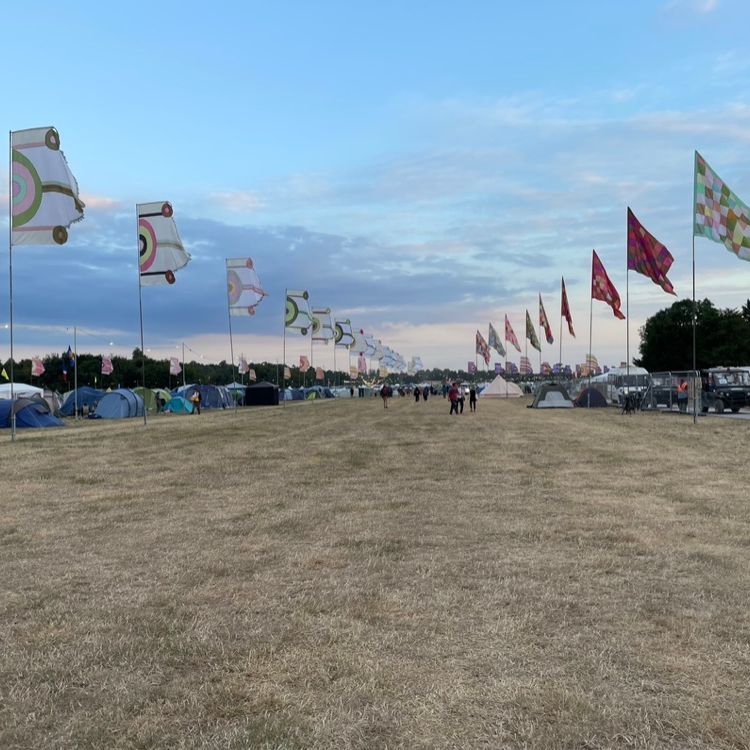
One of the best places to start thinking about contemporary festivals is Alessandro Falassi’s ‘Festivals: Definitions and Morphology’ (1987), which summarises a hundred years of anthropological and sociological theory about traditional festivals and compresses it into ten pages. Our word festival, he remarks, comes from the Latin festa, meaning times of ‘public joy’, and ‘abstinence from work in honour of the gods’. But Latin had another word for festivals, feria, which originally meant days away from work, too, and then came to mean the marketplaces and display of goods for sale, as with the Spanish ‘feria’ and the English ‘fair’. Festivals, then, are both time out and away from daily labour, and episodes of massive consumption, involving quite a lot of other people’s labour. It’s the situation you see at so many festivals now, where time away from your usual life sometimes resembles a tented shopping mall – not only because there is so much merch to buy but because the programme itself is a giant department store of art and artists, making browsing and comparison easy. One deep model for festivals has always been the religious, alternative to daily life type, gathering the community away from worries about status and money - and another the Expo or World’s Fair type. Some contemporary festivals are the second type pretending to be the first.
But Falassi’s real concern is not to see these as contradictions, but the ‘building blocks’ of festivals that all need to happen in order for the festival to do its core work, which is to give people a ‘time out of time’, a set-aside period ‘to renounce and then announce culture’. Festivals are there to allow people to reject or upset the usual orders of the world, and then, after a period of upheaval and boundarylessness, find space for a new, better-fitting order. The period of upset is better known as the ‘carnival’ feature of festivals made famous by Russian theorist Mikhail Bakhtin, where orders are overturned and slaves get to be masters or the sacred is defiled for a day – only to bring back the same old order the day after. Unlike the theorists of festival as thwarted revolution, Falassi gives festivals credit for change: they are there ‘to renew periodically the lifestream of a community by creating new energy’, he thinks. But to do that they need to go through several stages:
- The setting aside of a space for the festival, away from daily use
- The setting aside of time for the festival
- Rites of purification to allow the festival to begin
- Rites of passage (like transitions from winter to spring, or unmarried to married)
- Ritual drama (telling the founding story of the community, or going back into a less bounded and more polymorphous ‘creation time’)
- Status upsets, expressed through rites of competition, reversals of power, the exchange of goods (which is where the fair comes in) and also the settling of debts – the point is to level out the differences in stored-up value between everyone there so everyone ends on a level
- Rites of conspicuous display, consumption and excess: there must be processions and superabundance; too much must be eaten and drunk, and the prudent limits of the body overcome.
If all this results in episodes of chaos, it has to: only by disordering the current state of things and experiencing ourselves beyond some limit can the way we relate to ourselves or others be re-set.
I was thinking about Falassi’s grand theory of festival theories all the way through our time at WOMAD’s 40th anniversary festival. It was an intense, exhausting and exhilarating time, and thank you to all WOMADers who took pics and told us your stories, which we’ll talk about at a later part of the research. WOMAD is an international music festival mixing musicians from the global majority with British / American post-punk acts, and there are now three generations of WOMADers who come to dance, sing, enjoy the friendly atmosphere, stay up late and try their hand at puppet-making or playing the kora. Does any of Falassi’s description of what festivals have done in their long human history relate to a contemporary, Western, fairly pricey, liberal-commercial festival competing in a complex leisure marketplace for a slice of people’s holiday money? It’s not easy to describe what contemporary festivals do as ‘rites’, for example: there aren’t gestures or traditions or organised movements to tell people when and where to dance or sing. And yet, without most of the audience having read 100 years of festival anthropology, they certainly ticked some of Falassi’s boxes.
Contemporary rites
Set-aside time, for instance. Everyone has had to book time in their diaries, not easy in a super-busy world. On the bus in, people told me they make it an annual event around which they organise other visits and holidays: one fansite has people counting down ‘how many sleeps till WOMAD’. And here are the rites of separation, as people leave cars and work behind and get ticketed at the gates:
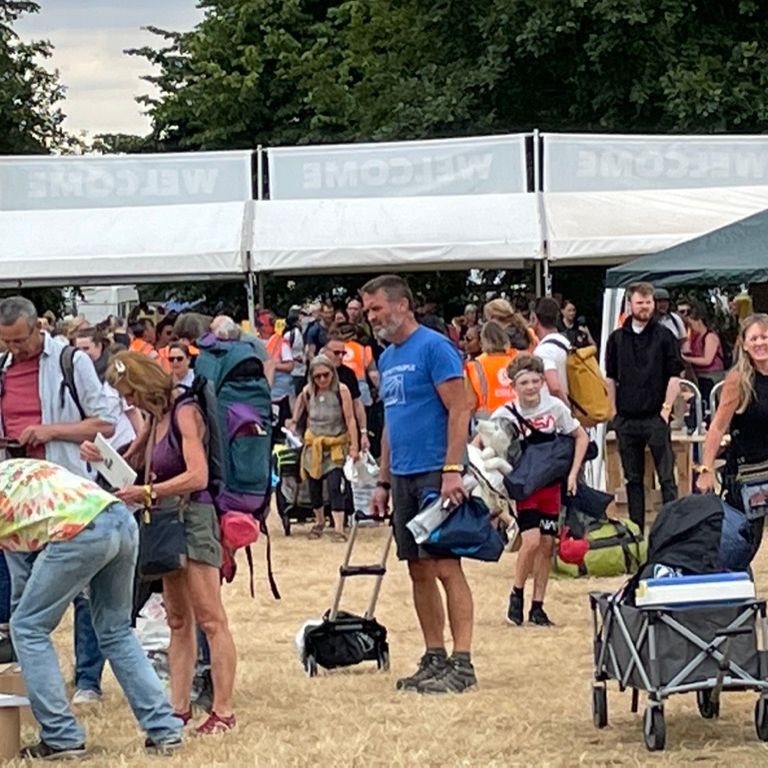
Here begins the conspicuous display, as people purchase their costumes:
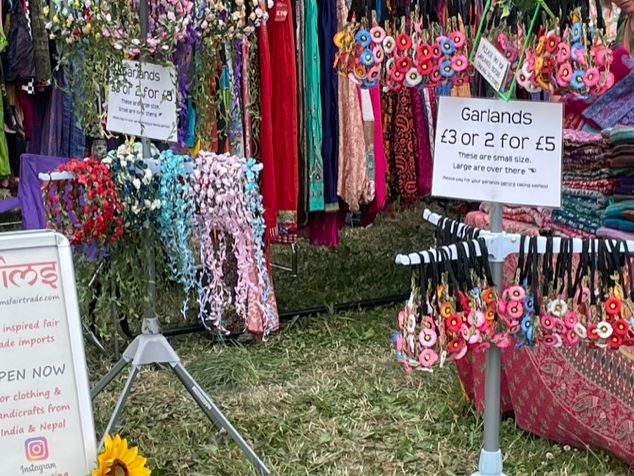
And now the rites of reversal begin: male and female...
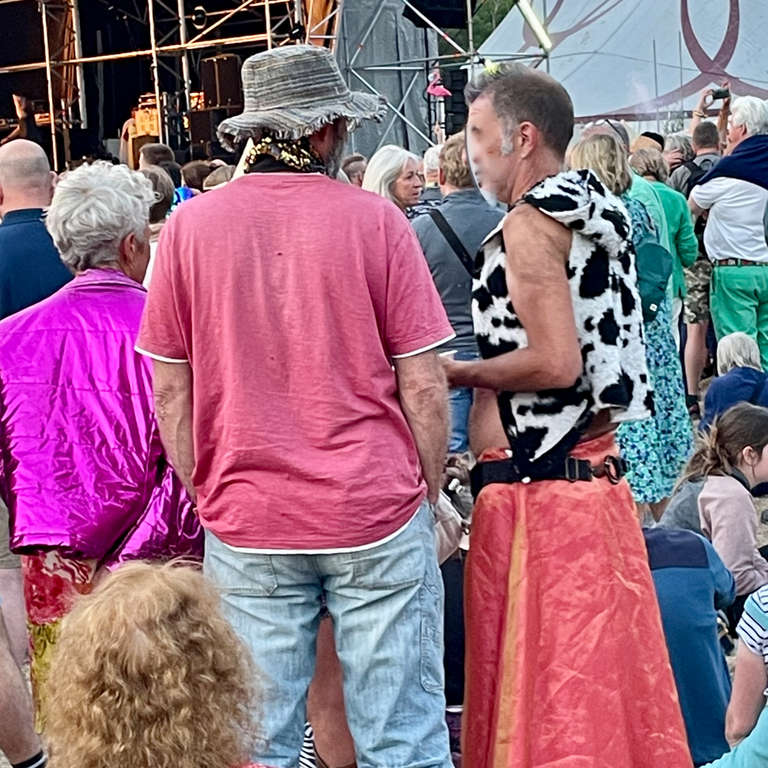
...authority and resistance (thanks to Anna Smith for this one)...
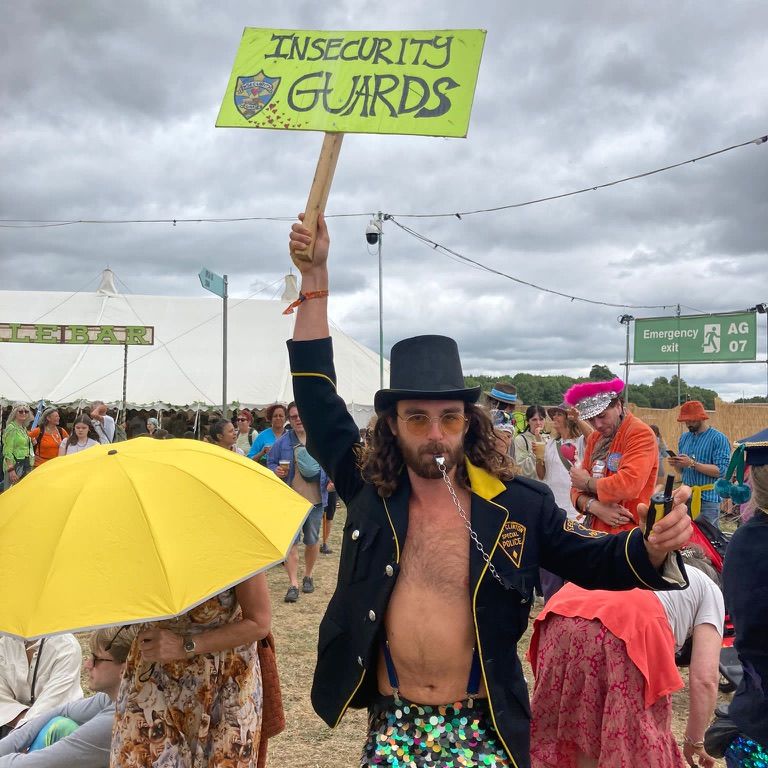
...or parents and children (who is dressing up here?)
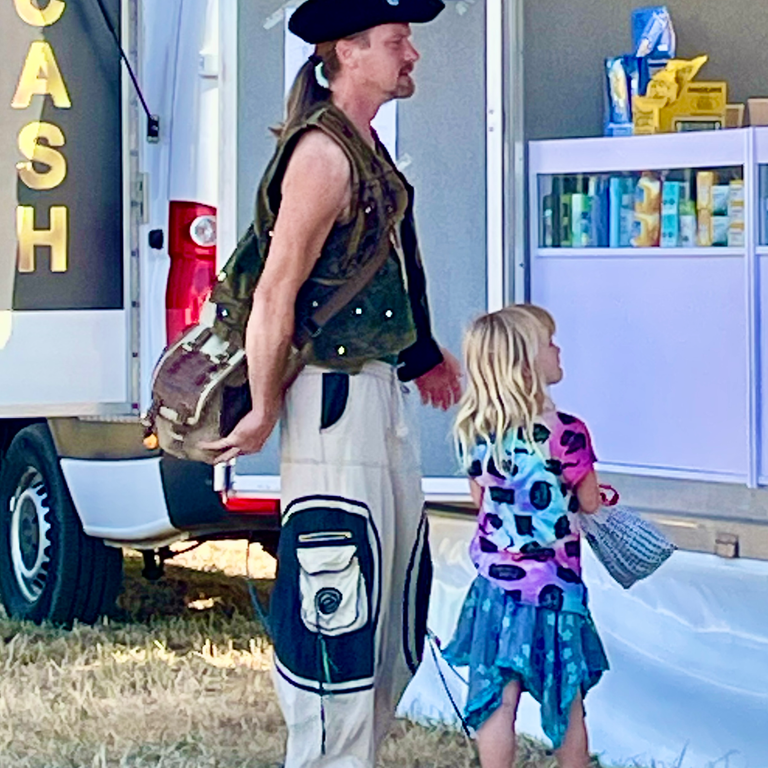
And most critically, the reversals of status between amateur and professional, or performer and audience in the Hip Yak tent poetry slam, where all slots were booked out within minutes - thanks to Rachael Bayliss for this rare shot of available space before the pleading began:
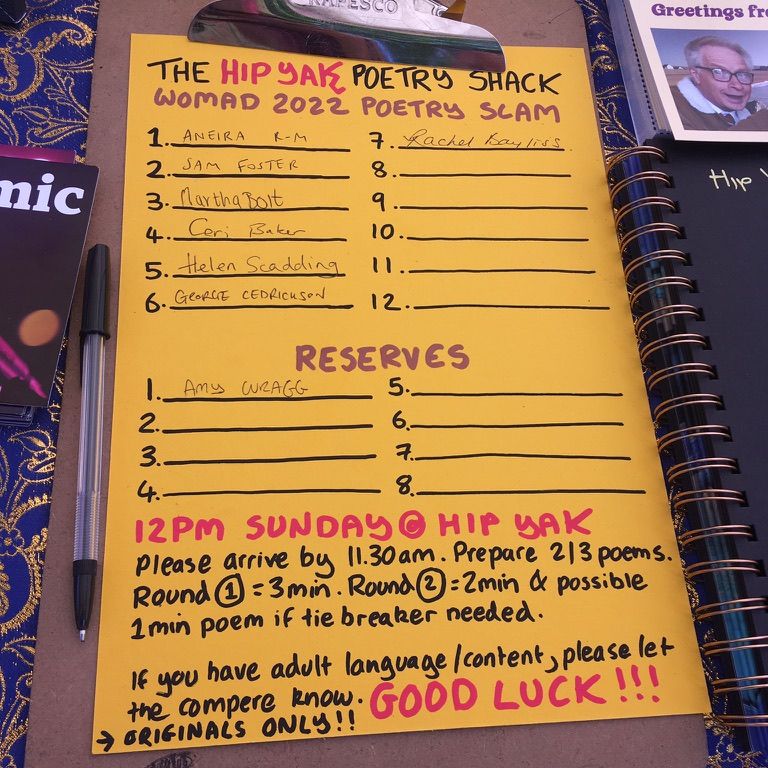
You can't miss the conspicuous display: everyone is on show, and the children help with the construction of items for the closing parade:
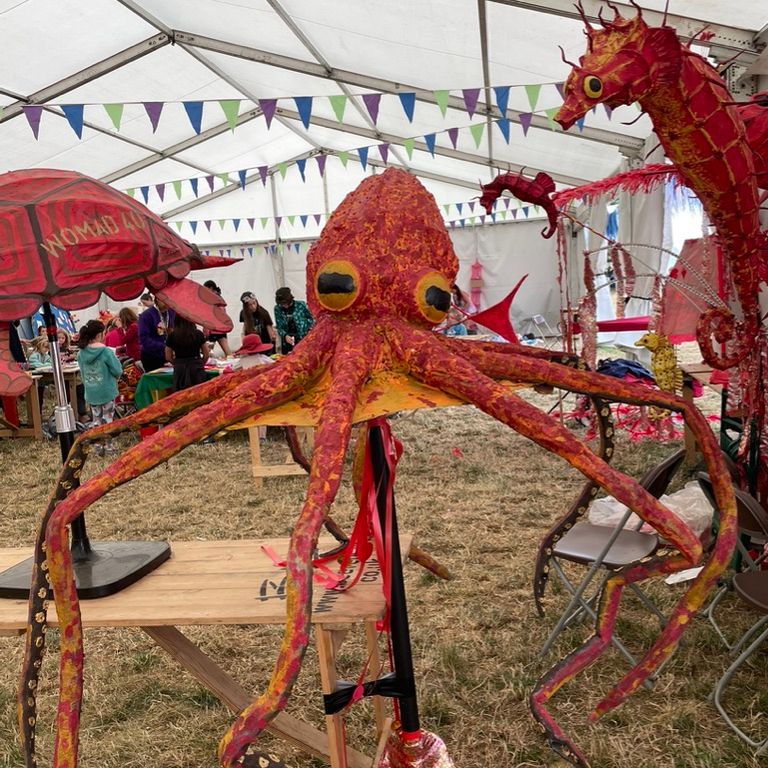
I don't have accurate information on how many boundary-dropping substances were consumed. But I did enjoy the dropping of some of the awkward social boundaries that afflict the white British middle class. During a rainstorm, I perched on a crowded table with a family I had never met before. Normally, there would have been a bit of a tense wait; here, within about a minute, we were sharing stories and they were sharing their picnic with me. Grandma confessed rather delightfully she had looked at the weather for Malmesbury, South Africa by mistake, and brought three grandchildren and no rain gear.
Missing rites?
But I was left a bit stumped by some of the other items on Falassi’s list. There were no ritual dramas being announced from mainstage, no connection with the ancestors, nor rites of passage. As we dug down into people’s stories around the poetry tent, though, something like them did emerge – but on an individual therapeutic level. This festival, its poetry and music seems to have brought up family conflict and exposed old patterns that weren’t working, to a surprising degree. People were recognising their own lives as if from outside, and sometimes re-entering them imaginatively. There is contact with the ancestors, but through working with family history and upbringing. As for rites of passage, many people were moving between jobs and all saw the festival as some kind of internal pivot. Rather than express communal rites of passage or founding stories, a festival in an individualised culture seems to allow people to bring their particular situations into the general matrix of the festival, which allows them to emerge and, after a period of chaos, perhaps resolve.
Falassi himself ends by saying that no festival can have all the building blocks, and especially not in an individualised, large-scale culture. In America, he observes, the different blocks get separated out into times of the year: Thanksgiving and Christmas for the ritual meal and conspicuous consumption, say, Halloween or Spring Break for rites of reversal, and the Superbowl for rites of competition. The calendar itself becomes a ‘festive cycle’, rather than everything being in a festival. In the UK, though, I think festivals like this are doing many of the elements at the same time. But some are more overt and some stay under the surface; some are collectively expressed, and others private journeys. Of course, all traditional festivals do private journeys too: no one comes without individual troubles or a life history to be shaped, though there may be fewer options for recognising it. What our interviews are telling us is how deeply the individual journey and the festival form are interlinked.
First Light Festival: a blog in two parts
Part 1: The high
The bright midday sun makes me squint as I emerge from First Light Festival’s windowless First Word tent. I had entered at 7.30am when the sky had been leaden with threatening clouds. The combined discomforts of a thin camping mat and the noise of a storm that had rumbled and crackled into the early hours had left me groggy and overtired. Now, though, as the sun beats down and the sea breeze brushes my skin, I feel alive. It’s partly the weather but I’m also buoyed up by the energetic rhythms and tales of Georgian debauchery that characterise Luke Wright’s award-winning spoken word show ‘The Ballad Seller’, which has just closed the First Word programme.
Slipping off my shoes, I walk along the sand to the festival’s kite-flying finale, the last of several festive rituals. I settle down on Lowestoft’s South Beach to drink in the last few moments of the festival’s atmosphere. Professional kites soar overhead, filling the sky with a rainbow of colours. Delighted children chase smaller, simpler kites, gripping strings in tight fists. The same laughter-filled wind that makes these kites dance and tickles my nose with the nostalgic tang of vinegar-drenched chips carries applause from the main stage as the final music act closes the festival. I wriggle my toes in the sand and tip my face up to the sun. My feeling of aliveness begins to sharpen. I feel euphoric.
In the weeks since my trip to First Light Festival, a twenty-four hour community arts festival hosted on the beach in Lowestoft, the UK’s most easterly town, I have been trying to make sense of this euphoria. In many ways, the festival had been a disappointment. It had begun with a parade of children from four local schools who took over the promenade, dancing and marching from Claremont Pier to the festival site on South Beach. The main stage (the ‘Sunlight Stage’) was opened with a performance of ‘The Light Returns’, a song commissioned to mark the return of summer but also the return of the festival after two years of Covid cancellations. The lead singer asked those gathered on the beach to dance and sing along with the chorus and the collective joy was palpable: I (and many others) wholeheartedly embraced festival director Genevieve Christie’s invitation to ‘come together at First Light’ right from the start. As textbook Falassian rites of separation from normal life, these communal opening moments seemed to promise a weekend of exemplary festivity. However, other rites and rituals were less successful. Take, for example, the burning of the ‘Pakefield Man’, a straw-filled iron sculpture inspired by evidence of early human life found only a short walk down the coastline. This ritual was intended as a moment at which festivalgoers would come together from stages across the site for a moment of community at midnight. After a lapse in security, however, the Pakefield Man was set alight by a group of inebriated youngsters half an hour before the carefully planned symbolic moment should have taken place.
Things went swiftly downhill from there: by midnight, a storm had rolled in and the festival’s organisers–who had promised a ‘non-stop’ programme ‘to celebrate one full cycle of the sun in Britain’s most easterly town’–were forced to cancel their overnight bookings for health and safety reasons. By this point, collective joy was hard to find. There was no dancing ‘until dawn under the midsummer sky’, though sleep-deprived campers, early arrivals and Lowestoft locals gathered at the water’s edge from 3.30am the next day, hopeful that the ‘unique sunrise programme of music and performance’ that had been planned to celebrate sunrise might still go ahead. Unbeknownst to us, the organisers had announced a cancellation of all pre-7.30am events on Facebook. So there we stood: a group of cold, damp people huddled on the shoreline, looking out across the sea as a dark grey sky became less dark by degrees but stayed resolutely grey. I wondered if there might be a moment of spontaneous festive community, if perhaps someone might sing a song or perform a poem, but nothing much happened. Sleepy, glitter-covered ravers stared deep into coffee cups while litter-picking volunteers scoured the sand for cans and plastic packaging - the festival’s flotsam and jetsam. People chatted quietly about what they had seen the previous day, shared storm stories, and gossiped about a drunken brawl among teenagers that was rumoured to have taken place after the festival site was evacuated. Overtired and underwhelmed, I went back to my tent.
These may not seem like conditions that would foster feelings of festive euphoria but by First Light’s ‘First Kite Fly-along Finale’, just a few hours after that overdue nap in a rain-soaked tent, euphoric was exactly how I felt. Despite all of the festival’s flaws I had been fully immersed in the First Light experience. These ‘flaws’ might even have contributed to my immersion. After all, nothing bonds strangers together like standing in the queue for the Portaloos in the early hours of the morning and laughing over recollections of Gabby Killick’s ‘Masturbation in Isolation’, an Eminem parody rap about socially-distanced cybersex which was one of the last things to be performed on the First Word stage before rain stopped play. To understand this (the euphoria, not the rap – you had to be there to understand that), I delved into the festival literature and discovered Vern Biaett’s work on ‘organic festivity’.
Biaett (2015) traces the origins of ‘organic festivity’ to the ‘primitive festivity’ of our ancestors, which was ‘unrefined’ and ‘spontaneous’. I am not as confident as Biaett that elements of the modern festival experience can be understood as similar, in some primal way, to early hunter-gatherers’ ‘festive experience of transcendence and feelings of ecstasy’. I do, however, share his interest in ‘moments of special delight, bliss, ecstasy, thrill, or pleasure that one experiences’ in festival contexts. While conducting research as a participant-observer at community festivals Biaett saw these feelings manifest as ‘unplanned, unprompted, impulsive shouts, crazy facial expressions, high-fived hand slaps, little dances, or group hugs’. My own feelings were not as outwardly visible but they were similarly thrilling. This is evident in my account of the final moments of the festival, during which I was an ‘active and engaged attendee’ (as opposed to a ‘passive’ spectator): a festivalgoer whose ‘senses were stimulated and [whose] emotions [were] aroused’ (Biaett, 2019).
Biaett’s model focuses solely on positive festival experiences and it is important to note that ‘impulsive’ festive behaviour (like the fight at First Light) can also be dangerous. My own experiences of ‘organic festivity’, however, were positive, and I encountered many ‘moments of special delight’ in the First Word Tent. While some poets read from collections, only pausing for applause, most invited ‘collaborative creative activity’ (Biaett, 2019): sets were conversational, inclusive, laugh-out-loud funny and furiously political - sometimes all at once. I learnt about the climate crisis courtesy of Francesca Beard’s ‘Geology Rocks’ and heard my first univocal poem (Jemima Foxtrot’s ‘Tess’ Ten Men’). I got goosebumps as I listened to Mike Garry perform ‘Spring Crossing’, a poem about refugees making perilous journeys which felt particularly poignant when performed next to Lowestoft’s ‘deep’, ‘cold’ sea. Garry’s set included the first of many deeply moving moments I would experience that weekend. There was light relief from Rob Auton, who performed a poem about small talk that resulted in a truly beautiful unscripted festival moment (I doubt I will ever see a tent full of people erupt in applause as a Tic-Tac is passes through the hole of a Polo mint again). Then came more deep feeling: I cried during Piers Harrison-Reid’s set as the Norfolk-based poet and nurse used his words to carve out a space for collective grief, gently coaxing out the trauma of the pandemic that we have all been so careful to repress. I felt rage as Elvis McGonagall, Salena Godden and Kate Fox delivered angry, rabble-rousing performances about the failings of those in power. But there was hope to be found amongst the fury, too. ‘Pessimism is for lightweights’, Godden reminded us.
Luke Wright’s programme of poetry was heart-wrenching and hopeful. It would have been moving in any context. But, as Biaett (2015) notes, ‘purely organic festivity is not something that can be programmed’: it bubbles up around programmed elements, between the lines of poems, and inside festivalgoers. It was the combination of the poetry and the joy of being part of a festival crowd after Covid and the sleep deprivation and the spectacular weather and countless other factors that culminated in the euphoric, organic feeling that I felt as First Light drew to a close. Our challenge as festival researchers is to be attuned to those special moments, to feel the ebbs and flows of the festival experience, and to remain open to the possibility of radical transformation.
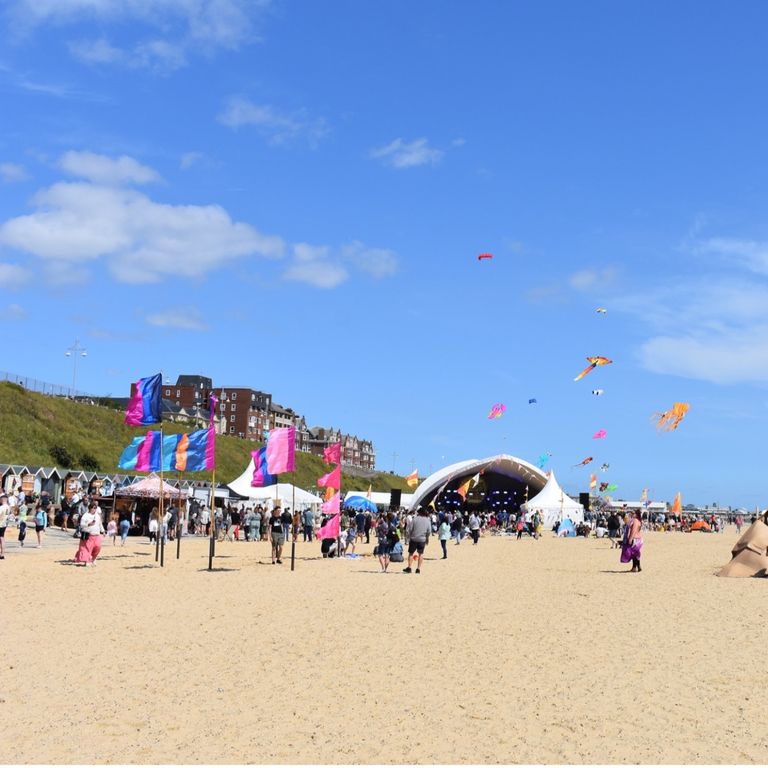
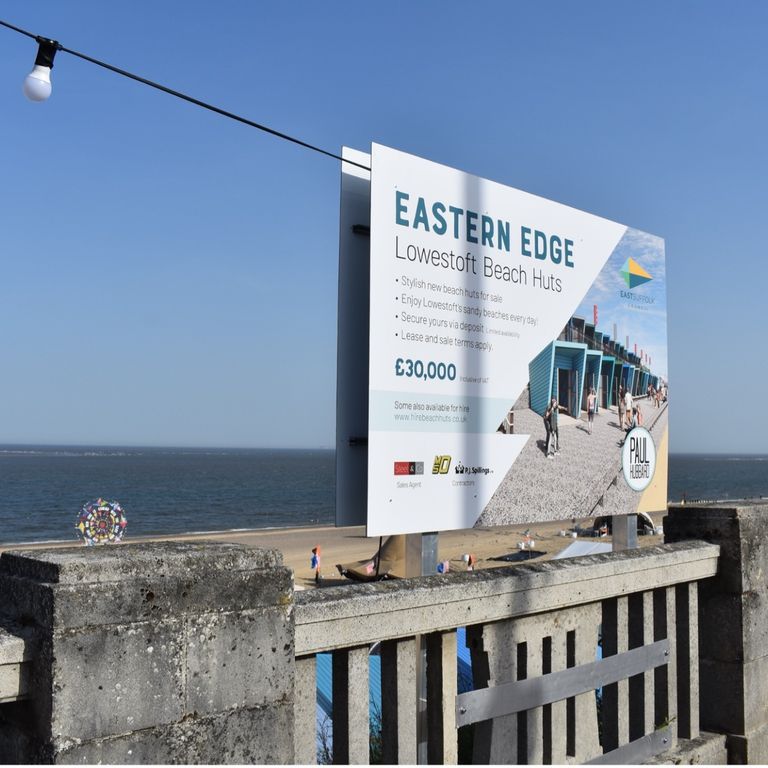
Part 2: The come down?
On the train home from First Light, as the joy I had felt there began to dissipate, I wondered who the festival was really for. Anyone who has read their Stanley Waterman might suggest that First Light Festival is little more than a ‘carnival for élites’. An especially cynical observer might even go so far as to call the festival gentrification. Viewed from this perspective, First Light is a shameless attempt to lure in new residents - people who might pay £30,000 for one of the stylish new beach huts that have recently been erected on Lowestoft’s South Beach, who might fritter away their disposable income on the craft beer and hand-stretched sourdough pizzas on offer in the East Point Pavilion (a beautiful council-owned building on the seafront which is operated by First Light CIC, the Community Interest Company behind the festival).
Town planners have made no secret of their intention to draw people to Lowestoft. The current Town Investment Plan states:
‘Lowestoft is… looking to attract a new creative community who want a different place experience with all the special sense of place, texture, and landscape the place provides from the Broads to industry and heritage to coastline. The opportunity to live and work in a historic setting such as old Lowestoft is massively appealing and affordable.’
First Light Festival left a deep impression upon me, a cultural tourist visiting for just a short amount of time. But I’m precisely the kind of millennial the authors of the Town Investment Plan have in mind: I crave a ‘creative community’ and one day I hope to live somewhere with a ‘special sense of place’. I love the coast and might be tempted by such an ‘opportunity to live and work’ there, especially if it were to be more ‘affordable’ than seaside towns that have already been gentrified, like Brighton and Margate. It began to dawn on me that this festival had been an immersive advert for Lowestoft targeted directly at me. I started to feel a little duped. As my train rolled towards Norwich and I left Lowestoft behind (for now), I wondered what First Light Festival had offered residents of the town’s most deprived areas.
I spoke to Christie the month after the festival to find out about First Light’s outreach. She spoke about the festival’s ‘grassroots’ beginnings and a highly successful pilot event involving a ‘marquee’ ‘stuck… across the High Street’ that made the team realise ‘that First Light had to be free’. Christie is clearly passionate about Lowestoft - a place that, she notes, ‘really has been under invested in’. She hopes to use art to ‘boost a sense of community in the town’ and describes the festival as part of a broader cultural strategy to prevent ‘flight to other places’. One of festival’s key roles, Christie suggests, is to provide local creatives with a place ‘to have their talent showcased in their home town’.
First Light was developed in response to the enthusiasm surrounding that first marquee-based event and also as an alternative to Latitude, a popular multi-arts festival ‘just… thirty-five minutes up the A12’ from Lowestoft which is financially out of reach for many of the town’s residents. First Light may be part of the town’s plan to attract new blood but it was also developed with Lowestoft’s existing community in mind. Christie conceded that the Coronavirus pandemic had put the brakes on some parts of the Festival’s 2020/21 Audience Development and Marketing Plan and had made ‘reaching those needy people harder’. But she was also proud of the work the First Light team had done (both online and in the community) in challenging times, and pleased with the ‘very, very diverse audience’ that the first post-Covid festival had attracted.
I was wrong, then, to equate cultural regeneration with gentrification so simplistically. Christie even encouraged me to think about those ‘controversial’ beach huts a little differently. Not only were they much cheaper to buy than those on offer on nearby seafronts–something similar in the affluent village of Walberswick might set you back over £120,000–but Lowestoft’s new beach huts could be rented from the council at affordable rates. Christie was also keen to point out that these beach huts were proof of the ‘confidence’ that the festival has instilled in Lowestoft. The success of First Light has been a ‘catalyst’ and has encouraged organisations across the town to apply ‘for more public funding to make more events’ and to develop ‘infrastructure to support cultural activity’. A new Cultural Quarter and other redevelopment projects will provide workshop space for creatives and venues where work ‘of scale can happen’. This will, in turn, present opportunities for year-round operation, extending First Light’s impacts beyond its long weekend of festivity.
The festival team is ‘still feeding back from this year’ and taking time to ‘think carefully’ about the ‘shape’ that the festival might take in future years. Christie is keen to ‘grow’ community involvement, and not just in terms of attendance figures. She hopes to encourage deeper participation that would foster a ‘real feeling of ownership’ amongst local people from all of Lowestoft’s wards. I, for one, can’t wait to see what the festival and its community create together next.
Sources:
- Vern Biaett, ‘Organic Festivity: A missing element of community festival’, in Allan Jepson and Alan Clarke, eds., Exploring Community Festivals and Events (London: Routledge, 2015), 17-30;
- Biaett, ‘Festivity and Attendee Experience: A confessional tale of discovery’, in Judith Mair, ed., The Routledge Handbook of Festivals (Oxford: Routledge, 2019), 244-262;
- Lowestoft Town Investment Plan <https://www.eastsuffolk.gov.uk/assets/Business/Regeneration-projects/Lowestoft-Investment-Plan/Lowestoft-Town-Investment-Plan.pdf>;
- Interview with Genevieve Christie, 2 August 2022.
We need your consent to load the translations
We use a third-party service to translate the website content that may collect data about your activity. Please review the details in the privacy policy and accept the service to view the translations.

